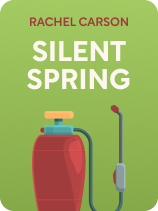

This article is an excerpt from the Shortform book guide to "Silent Spring" by Rachel Carson. Shortform has the world's best summaries and analyses of books you should be reading.
Like this article? Sign up for a free trial here.
What are the different types of pesticides? What’s the difference between herbicides and insecticides?
In Silent Spring, Rachel Carson discusses how and why chemicals are applied to the environment. She also describes how insecticides and herbicides are used, and the harmful effects they have on the environment and humans.
Keep reading to learn more about the different types of pesticides that are dangerous.
What Are Pesticides?
Carson describes pesticides as chemicals applied to the environment to eliminate or reduce the population of a plant, insect, or animal. Many of these poisons were first discovered in the development of chemical weapons for World War II. After the war, different types of pesticides were used to increase crop production by eliminating potential predators and to control weeds and pests like houseflies in suburban areas. They were also sometimes used in conservation efforts; for example, to control overpopulation by “invasive” or non-native species. However, Carson argues that the dangers pesticides pose to the environment ultimately outweigh the economic and agricultural advantages of pest control.
(Shortform note: “Pesticide” technically describes any substance used to control the spread of pests, and thus includes tactics like spraying natural chemicals such as neem oil to repel insects. Carson’s focus is on synthetic or chemical pesticides that kill indiscriminately, as these have the greatest capacity to damage a whole ecosystem. In addition to their origins in wartime research, some of these chemicals were actually used as weapons—most famously, the US military dropped the herbicide Agent Orange on Vietnam throughout the 1960s in an attempt to destroy the Viet Cong’s shelters and food supply. It’s estimated that over a million Vietnamese people suffered from cancer and birth defects as a result of exposure.)
Though Carson believes that pesticides can be used safely in smaller or less poisonous doses, she condemns the “indiscriminate” spraying practiced by the US at the time the book was published, in which hundreds of acres would be treated at once. She argues that even when these campaigns are successful, the effects aren’t limited to the targeted pest, but damage the environment as a whole. Poisons that are effective against one type of insect or plant are generally successful at killing dozens of other species, as well as birds, fish, small mammals, farm animals, pets, and even people. Chemicals can also easily spread through soil, runoff, or the food chain to affect surrounding water supplies and ecosystems.
(Shortform note: Carson’s critique of pesticides is informed by her background in ecology, a field of biology which understands all living organisms as fundamentally interconnected, particularly those that share environmental resources or prey on each other. Any change to an environment or to the behavior of an individual species—such as introducing pesticides—has the potential to affect all other organisms in that environment. Later ecologists would make similar arguments to Carson’s about the effects of climate change; warming temperatures and rising sea levels could affect not just individual species but the global ecosystem as a whole, and the disappearance of one life form could mean the deaths of many others.)
There are two major types of pesticides: insecticides, which target insects, and herbicides, which target plants. Many of the same chemicals can be used as both insecticides and herbicides.
Insecticides
Insecticides are pesticides used to control the spread of insects, especially those that threaten to spread disease to humans or to cash-producing plants like balsam trees, sugarcane, and cotton. Carson argues that insecticides became increasingly popular as monoculture farming—the practice of devoting an entire field or fields to a single crop—became more common in the early 20th century. Monoculture farming is especially vulnerable to losing an entire crop to infestation, and the US government responded to this threat by promoting insecticides, both using them in its own massive chemical campaigns and approving their commercial use by farmers and suburbanites.
(Shortform note: While monoculture farming can increase productivity and profits by allowing farmers to focus on the conditions and specialized equipment required for a single plant, ecologists argue that the practice lowers the quality of the soil, consumes excess water, and reduces biodiversity. Outside of agriculture, the most common example of a monoculture is the suburban lawn, where grass is grown and maintained through mowing to give a “green” look to a neighborhood. In recent years lawns have been widely criticized as being environmentally unfriendly and a waste of space that could be used for fruit, flower, or vegetable gardens.)
Carson describes two major categories of pesticides: chlorinated hydrocarbons, which have a carbon base, and alkyl or organic phosphates, based on phosphoric acid. Hydrocarbons like chlordane, dieldrin, endrin, and DDT can cause severe liver and kidney damage in some animals, and may cause hepatitis. Phosphates like malathion and parathion can damage the nervous system, causing tremors or convulsions before death. These chemicals are often mixed with oil or arsenic for delivery to the environment and can be absorbed through the skin, breathed in, or consumed. Carson notes that malathion and parathion in particular are similar in chemical makeup to nerve gases developed by the German government during World War II.
(Shortform note: Though Carson focuses on many pesticides besides DDT, that chemical would become the focus of environmentalist campaigns throughout the 1960s and early ’70s, including mentions in folk songs and prompting the formation of the nonprofit Environmental Defense Fund. Finally, in 1972, the Environmental Protection Agency (EPA) banned most uses of DDT in the US, though the chemical could still be produced for export. In 2001, the UN’s Stockholm Convention on Persistent Organic Pollutants banned the use of DDT in agriculture worldwide but permitted its continued use in antimalarial campaigns. Many of the other chlorine-based pesticides Carson discusses are also still in use, as is malathion.)
Herbicides
Herbicides are pesticides used to control the spread of plants, generally to prevent them from encroaching on farmland or to replace “unproductive” land with plants that can be used for agriculture or animal husbandry. This can be on a large scale, as in the attempts to replace the sagebrush lands of the midwestern US with grasslands for sheep and cattle, or on a small scale, as in the individual spraying of private lawns, parks, and golf courses to remove weeds in favor of trees and flowering bushes. Carson criticizes both practices, arguing that the designation of some plants as undesirable is arbitrary (grass itself is sometimes considered a weed) and disrupts the natural balance of the environment.
(Shortform note: Though Carson’s work predates the scientific philosophy of deep ecology, her defense of weeds similarly argues that all life has value outside of its utility (or lack thereof) to humans. Some of the plants humans uproot for being “ugly” or unprofitable are actually important to the health of the surrounding ecosystem. Beyond the ecological argument, the designation of some plants as weeds has also been criticized from an anti-colonial perspective. Indigenous scholars have argued that colonizing forces will declare native plants undesirable and introduce invasive species as a way to undermine native agricultural practices and exploit the land for their own purposes.)
According to Carson, many insecticides are also used as herbicides, including DDT, dieldrin, and malathion. Other widely used chemicals include the chlorinated hydrocarbons lindane, DDD and heptachlor, the arsenic-based sodium arsenite, and metabolic stimulants like dinitrophenol and pentachlorophenol, which cause the target’s body temperature to rise until death. Similarly, the herbicide 2,4-D causes uncontrolled growth in the targeted plant, leading it to run out of energy and die. Carson notes that there are numerous documented cases of people suffering nerve damage, fatigue, and muscular weakness after breathing in or having skin contact with these herbicides.
(Shortform note: Though some of these herbicides, such as dieldrin, have since been banned in the US, lindane, sodium arsenite, pentachlorophenol, and 2,4-D are all still in use—not just as herbicides but also as a scabies and lice treatment, an ingredient in soap, and a wood preservative, though the use of pentachlorophenol on wood is currently being phased out. Another herbicide, DNP, has similar effects to 2,4-D and has been used as a component in explosives and even a weight loss drug, since an increase in temperature and energy consumption can cause the body to shed fat.)

———End of Preview———
Like what you just read? Read the rest of the world's best book summary and analysis of Rachel Carson's "Silent Spring" at Shortform.
Here's what you'll find in our full Silent Spring summary:
- How pesticides threaten to devastate the environment and poison humans
- Why there should be stricter regulation of pesticides in the US
- How this 1962 book inspired the environmentalist movement of the 70s






